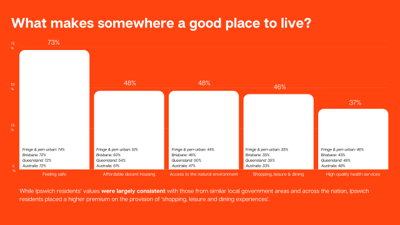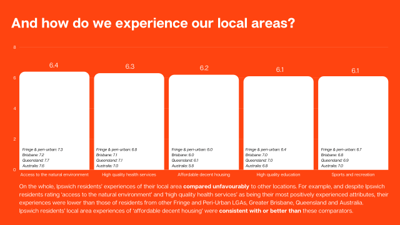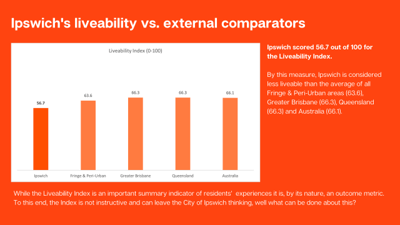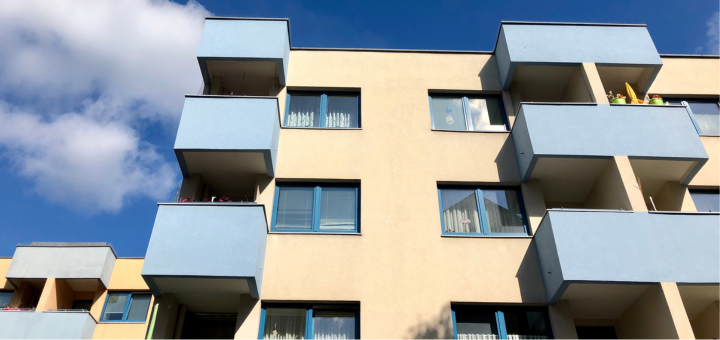This brief case study discusses the City of Ipswich’s experience working with .id to deliver their first annual Living in Place project. It talks through why the City needed Living in Place, some of the specifics around how the project was administered, what was learned and how it will help the City make more resident centric decisions in the future.
About the City of Ipswich
Traditionally known as Tulmur in the local Yagara language, Ipswich – as it is called today – is located 40km south-west of Brisbane’s CBD. One of Queensland’s oldest provincial cities, Ipswich has served many roles and functions over the years, including as a mining region and as a centre for agriculture.
Today, the city’s main industries (by employment) are healthcare and social assistance and retail trade. Ipswich continues to be one of Queensland’s manufacturing centres, with local levels of employment in this sector close to double the state average.
Ipswich is one of the nation’s fastest growing regions – adding just under 100,000 new residents in the ten years to 2020. Despite already being home to 220,000 people, Ipswich is predicted to grow even more, with some estimates suggesting that the city will expand to more than 400,000 residents by the mid-2030s.
Context and the need for Living in Place
Like all councils, the City of Ipswich delivers and undertakes routine reviews of its community vision, council planning and advocacy requirements to ensure the planning and priorities are aligned with the community’s changing needs.
When considering the requirements for the forthcoming 2021-26 Corporate Plan for the City, council decided it needed to understand its residents on a deeper level to ensure it was designing a vision and plan that not only responded to the community’s requirements of today, but also set course for a more prosperous longer term. The critical questions without answers were…
- What do our residents value, and how do they experience their local area?
- How liveable is the City of Ipswich currently, and what needs to happen to advance quality of life?
In September 2020, the City of Ipswich engaged .id to deliver our Living in Place offer to help progress understanding against these questions.
The balance of this case-study demonstrates how Living in Place provided the City with a deep and representative understanding of its community’s values, experiences and needs, and how it will be used as a resident-centric evidence base to inform, monitor and evaluate the City’s 2021-26 Corporate Plan and ongoing advocacy.
What do the residents of Ipswich value, and how do they experience their local area?
By employing the Living in Place offer, the City learnt that three-quarters (73%) of residents surveyed selected ‘feeling safe’ as one of their top five attributes that they believe makes somewhere a good place to live, followed by half who chose the provision of ‘affordable decent housing’ (48%) and ‘access to the natural environment’ (48%). The 4th and 5th most important attributes were ‘a diverse range of shopping, leisure and dining experiences’ (46%) and ‘high quality health services’ (37%).
While Ipswich residents’ values were largely consistent with those from similar local government areas and across the nation, Living in Ipswich advised that the City’s residents place a relatively higher premium on shopping, leisure and dining and somewhat of a lesser value on health services.
When asked to rate their local area experiences on a scale between 0 & 10 against all 16 attributes, Ipswich residents’ most positive experiences included ‘access to the natural environment’ (6.4), ‘high quality health services’ (6.3) and ‘affordable decent housing’ (6.2). While we learnt that Ipswich residents’ experiences of their local area compared unfavourably to other locations across most attributes, we also learnt that Ipswich residents’ local area experiences of ‘affordable decent housing’ were consistent with, or better than, those from elsewhere across the nation.


How liveable is the City of Ipswich, and what needs to happen to advance quality of life?
Ipswich residents delivered an Overall Liveability Index (OLI) of 56.7 out of 100. By this measure, Ipswich was considered less liveable than the average of all Fringe & Peri-Urban areas (63.6), Greater Brisbane (66.3), Queensland (66.3) and Australia (66.1). While Ipswich’s OLI is an important indicator of the relationship between the City’s residents’ values and experiences it is, by its nature, an outcome metric. To this end, the Index is not instructive and can leave the City of Ipswich thinking, well what can be done about this?
Analysing the relationship between residents’ values and experiences is a key feature of Living in Place, as it enables the creation of localised community needs – expressed in Living in Place as ‘areas to maintain’, and ‘areas to improve’.
Living in Place for the City of Ipswich identified the top four areas to maintain (attributes of greater importance to the community with relatively better local area experiences) as ‘affordable decent housing’, ‘access to the natural environment’, ‘high quality health services’ and ‘making your way to and from services such as employment, education and healthcare with relative ease’. The top four areas for improvement (attributes of greater importance to the community with relatively worse local area experiences) were identified as ‘feeling safe’, ‘shopping, leisure and dining experiences’, ‘a lack of road congestion’ and ‘a strong sense of community’.
Addressing these community needs through policy and/or advocacy may result in residents reporting more positive local area experiences and, by extension, an improvement to overall liveability across the LGA.


So what happens next?
At the time of writing, the City was in the process of finalising their new Corporate Plan – which will commence on 1 July 2021 and run through to 2026.
Just as the Living in Ipswich survey results and key findings were used to inform the Plan’s core themes, the City has committed to the Living in Place program for a further 3 x years to give their residents a credible voice as they monitor progress against their community planning and advocacy agenda. The City recognises that the diversity of attributes included in Living in Place allows Council to not only use it as a resource to inform how residents believe they are progressing across a range existing community and strategic planning objectives, but to also use it to inform the creation, monitoring and evaluation of others.
If you’re keen to learn more about how Living in Place can help your council make more resident centric decisions, please check out this 90 second video that summarises the offer, feel free to get in touch or book a meeting. We’ve also written a blog discussing our deeper thinking the need for the offer.













